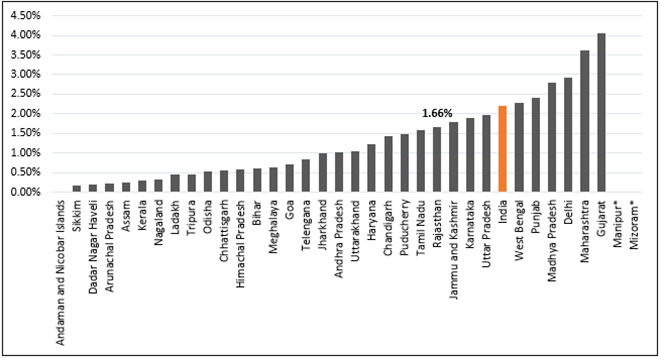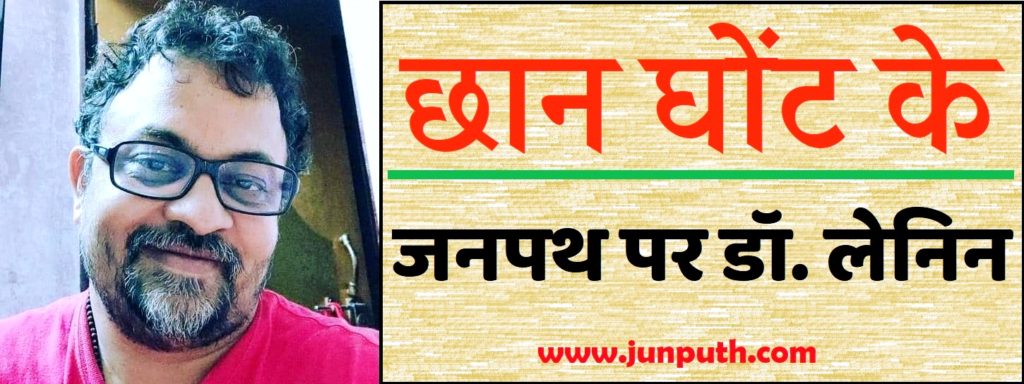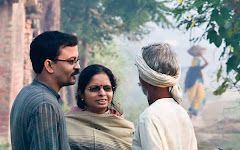https://gaonkelog.com/the-life-crisis-in-front-of-the-desolate-weavers-of-banaras-is-deepening/
Thursday, September 16, 2021
बनारस के उजड़ते बुनकरों के सामने आजीविका का संकट गहराता जा रहा है
Tuesday, September 14, 2021
Centre for Cognitive Activities, NIT Durgapur profiled Lenin
Sunday, September 5, 2021
छान घोंट के: 60 फीसदी मौतों के पीछे छुपी दूसरी महामारी NCD पर बात करने का यही सही वक्त है!
https://junputh.com/column/chhaan-ghont-ke-malnutrition-nutrient-profiling-front-pack-labelling/
छान घोंट के: 60 फीसदी मौतों के पीछे छुपी दूसरी महामारी NCD पर बात करने का यही सही वक्त है!
जब मैं कोविड की चपेट में आया और सघन चिकित्सा के लिए 12 दिनों तक अस्पताल में मुझे रहना पड़ा, तब पता चला कि प्रोटीनयुक्त भोजन और पोषण रोग प्रतिरोधक क्षमता के साथ कोरोना से ग्रसित इंसान को सामान्य अवस्था में लाने मदद करता है। मेरा अपना अनुभव तो यही है।
इस संदर्भ में भारत की स्थिति को देखें, तो एक तरफ जहां बच्चे कुपोषण से मर रहे हैं, वही दूसरी तरफ मोटापा चिंता का विषय बन चुका है। ऐसे में मैं आपका ध्यान एक साइलेंट किलर- गैर-संचारी रोगों (नॉन कम्यूनिकेबल डिजी़ज-एनसीडी) की ओर आकर्षित करना चाहता हूं, जो भारत में रुग्णता और मृत्यु दर का प्रमुख कारण है। जैसा कि आप जानते हैं, चाहे ताजा भोजन हो या पहले से पैक किया हुआ डिब्बाबंद भोजन- वसा, नमक या चीनी में उच्च भोजन का अधिक सेवन अकसर मोटापे और एनसीडी के लिए प्रमुख जोखिम कारक होते हैं।
भारतीय आयुर्विज्ञान अनुसंधान परिषद (आइसीएमआर) की रिपोर्ट ‘इंडिया: हेल्थ ऑफ़ द नेशंस स्टेट्स’ के अनुसार, वर्ष 2016 में होने वाली कुल मौतों में गैर-संचारी रोगों का योगदान 61.8% था। गैर-संचारी रोग ऐसी दीर्घकालिक बीमारियां हैं जो एक व्यक्ति से दूसरे व्यक्ति में नहीं फैलती हैं, जैसे- कैंसर, मधुमेह और हृदय रोग, जबकि संचारी रोग तेज़ी से संक्रमण करते हैं तथा एक व्यक्ति से दूसरे व्यक्ति में अतिशीघ्र फैलते हैं, जैसे- मलेरिया, टायफायड, चेचक, इन्फ्लुएन्ज़ा आदि।
रिपोर्ट के अनुसार, केरल, गोवा और तमिलनाडु में महामारी के संक्रमण अर्थात संचारी रोगों के कारण क्षेत्र में मृत्यु के मामले कम पाये गए जबकि मातृत्व, नवजात एवं पोषण संबंधी गैर-संचारी बीमारियां मृतकों की संख्या में वृद्धि कर रही हैं।
गैर-संचारी रोग (NCD)
- गैर-संचारी रोगों को दीर्घकालिक बीमारियों के रूप में भी जाना जाता है क्योंकि ये लंबे समय तक बनी रहते हैं तथा ये एक व्यक्ति से दूसरे व्यक्ति में नहीं फैलते हैं।
- गैर-संचारी रोग के जोखिम उम्र बढ़ने, अस्वास्थ्यकर आहार, शारीरिक गतिविधि की कमी, उच्च रक्तचाप, उच्च रक्त शर्करा, उच्च कोलेस्ट्रॉल तथा अधिक वज़न आदि के कारण बढ़ रहे हैं।
- आमतौर पर ये रोग आनुवंशिक, शारीरिक, पर्यावरण और जीवन-शैली जैसे कारकों के संयोजन का परिणाम होते हैं।
- यह एक आम धारणा है कि बढ़ती आय के साथ आहार संबंधी व्यवहार, अनाज और अन्य कार्बोहाइड्रेट आधारित भोजन से फलों, सब्जियों, दूध, अंडे और मांस जैसे पोषक तत्त्वों से समृद्ध विकल्पों की तरफ झुक जाता है।
- ऐसे खाद्य उत्पाद ऊर्जा-गहन (Energy-dense) और वसा, शर्करा तथा नमक की उच्च मात्रा से युक्त होते हैं जो इनके उपभोक्ताओं की NCDs और मोटापे के प्रति सुभेद्यता को बढ़ाते हैं।
- गैर-संचारी रोगों की रोकथाम और इन पर नियंत्रण हेतु वैश्विक कार्रवाई के तहत विश्व स्वास्थ्य संगठन (WHO) की योजना में चार मुख्य NCD शामिल किये गए हैं, जो कि निम्नलिखित हैं:
- हृदयवाहिनी बीमारियाँ (Cardiovascular Diseases-CVD) जैसे-हार्ट अटैक एवं स्ट्रोक
- कैंसर
- दीर्घकालिक श्वास संबंधी बीमारियाँ
- मधुमेह (Diabetes)
- विश्व स्वास्थ्य संगठन के अनुसार हृदय संबंधी विकार, कैंसर और मधुमेह सहित गैर-संचारी रोग भारत में लगभग 61% मौतों का कारण बनते हैं।
- इन बीमारियों के कारण लगभग 23% लोगों पर प्री-मैच्योर (समय से पहले) मौत का खतरा बना हुआ है।
- सार्वजनिक स्वास्थ्य का विषय हालांकि राज्य सूची के अंतर्गत आता है, केंद्र सरकार राज्य सरकारों के प्रयासों में पूरक का कार्य करती है।

भारत में एनसीडी के बढ़ते प्रसार को संबोधित करने के लिए भारतीय खाद्य सुरक्षा मानक प्राधिकरण (एफएसएसएआइ) सभी डिब्बाबंद खाद्य पदार्थों के लिए फ्रंट ऑफ पैकेज लेबल्स (एफओपीएल) के लिए एक विनियमन पर सक्रिय रूप से विचार कर रहा है। देश में एफओपीएल विनियमन लाने का इससे बेहतर समय कोई नहीं होगा जब कोविड महामारी ने बच्चों के स्वास्थ्य और कल्याण सहित सार्वजनिक स्वास्थ्य के सार्वजनिक बहस के केंद्र स्तर पर ला दिया है, साथ ही हर भारतीय की कल्पना को पकड़ लिया है। बच्चों और युवा आबादी में बढ़ते मोटापे और एनसीडी के उच्च प्रसार को देश दूसरी महामारी के रूप में देख रहा है।
विश्व स्वास्थ्य संगठन (डब्ल्यूएचओ) बताता है कि फ्रंट ऑफ पैक लेबलिंग (एफओपीएल) राष्ट्रों के नागरिकों के लिए स्वस्थ भोजन विकल्प प्रदान करने के लिए एक महत्वपूर्ण नीति उपकरण है और दक्षिण एशिया के लिए पोषक तत्व प्रोफाइल मॉडल (एनपीएम) सहित विभिन्न क्षेत्रों के लिए एफओपीएल पर मार्गदर्शक सिद्धांत और ढांचा मैनुअल प्रदान करता है। एनपीएम परिभाषित करते हैं कि क्या किसी खाद्य उत्पाद में चीनी, नमक और वसा का अत्यधिक स्तर है और यह बताता है कि प्रत्येक पोषक तत्व के लिए महत्वपूर्ण सीमा क्या है।
अतः उद्योग के प्रभाव या फिर किसी प्रकार के प्रभाव से मुक्त होकर विशेषज्ञ यह तय करें कि विश्व स्वास्थ्य संगठन द्वारा एनपीएम के क्षेत्रीय प्रारूप या अंतर्राष्ट्रीय सर्वोत्तम अभ्यास (Best Practices) में से एक देश में लागू हो।

पोषक तत्व प्रोफाइल मॉडल और फ्रंट ऑफ पैकेट लेबलिंग (एफओपीएल) विनियमन पर सरकारी विचार-विमर्श सहित सार्वजनिक चर्चा को आकार देने में सक्षम वातावरण बनाने के लिए हस्तक्षेप और जनता के बीच बहस बहुत जरूरी है। देश में एफओपीएल विनियमन में निम्नलिखित सिद्धांत सुनिश्चित करने के लिए हमारा सरकार और राजनैतिक दलों से अनुरोध है, जो भारत को बच्चों के स्वास्थ्य की रक्षा करने के साथ-साथ खाद्य प्रसंस्करण उद्योग द्वारा निर्मित और विपणन किये गए स्वस्थ खाद्य उत्पादों को समर्थन और बढ़ावा देने में मदद करेगा।
- पैकेज लेबलिंग (FOPL) सबसे स्पष्ट तरीके से सटीक जानकारी के साथ उपभोक्ता को सशक्त बनाये और उपभोक्ता को उन खाद्य उत्पादों के बारे में जागरूक करना चाहिए जिनमें वसा, चीनी और नमक की मात्रा अधिक होती है।
- एक पोषक तत्व प्रोफाइल मॉडल को शामिल करें जो पैकेज भोजन के माध्यम से नमक, चीनी और वसा की उच्च खपत को सीमित करता हो, जिससे बच्चों और युवा आबादी सहित जनता के लिए स्वस्थ जीवन को स्थापित करने में मदद मिलती है।
खाद्य प्रसंस्करण उद्योग व डिब्बा बंद भोजन से जुड़े उद्योग धंधे के विकास के खिलाफ एक विज्ञान आधारित प्रभावी एफओपीएल (FOPL) विनियमन नहीं देखा जाना चाहिए। हम दृढ़ता से मानते हैं कि खाद्य प्रसंस्करण उद्योग महत्वपूर्ण है, वास्तव में देश के मजबूत आर्थिक विकास के लिए महत्वपूर्ण घटक है। खाद्य प्रसंस्करण उद्योग रोजगार के अवसर पैदा करके, अधिक विदेशी मुद्रा लाकर और किसान की आय को बढ़ाने के साथ देश की अर्थव्यवस्था के लिए बहुत महत्वपूर्ण है। हमारा मानना है कि एफओपीएल देश में खाद्य प्रसंस्करण उद्योग को स्वस्थ भोजन की मांग में खड़ा कर उनके बाजार को मजबूत करने में मदद करेगा।
यह भारत में बनाया गया अनूठा अवसर होगा, जो भारतीय खाद्य प्रसंस्करण उद्योग को आगे बढ़ाने और अधिक विदेशी निवेश को आकर्षित करने में मदद करेगा। भारत को इस मोर्चे पर सबसे अच्छे उदाहरणों में से एक के रूप में लाने के लिए हम सभी को दबाब बनाना जरूरी है।

#COVID #FOPL #LeninRaghuvanshi
Thursday, September 2, 2021
Converting Corona Crisis in to opportunity for resilience, humane dignity and hope
The announcement of lockdown as a measure to prevent and curb the spread of corona virus, most Dalit families faced accentuated deprivations and marginalization, heightening their struggle for survival. Vast majority of the Dalits encountered loss of livelihood and food insecurity as they earn and spend on a daily basis, with hardly any savings for the rainy day. With restriction of movement and inability to go and work, many families are on the verge of starvation, with hardly any means to survive. They do not have cash to buy food grains and sustain life. There were many instances reported in the newspapers that Musahars are feeding their children chappatis made of Ankari grass and salt, the grass that is fed to the cattle. Some families are surviving on the left-over food and discarded potatoes in the fields.
The second wave of COVID-19 crisis had affected the lives of poor, vulnerable, internally displaced people and the migrant communities they became from poor to poorest and living in the verge of survival. They are having place to stay but don’t have money to sustain their life due to partial restriction they are unable to go and work outside. These communities are mostly landless workers, weavers, begging, survivors of human rights violation and COVID survivors.
During the course of intervention, we found that condition of the pregnant and lactating mother and individual migrant labour are vulnerable. They are not getting nutritious diet, which will lead to anemia, higher risk in pregnancy and malnutrition in children. Moreover, the high rate of anaemia amongst women has a negative impact on their future pregnancies, leading to the birth of potentially anemic children. In last fifteen month i.e., from the first wave to the second wave 348 babies (172 F and 176 M) were born. Out of which 13 babies (8 F and 5 M) died, and 8 still deaths (4/4) were recorded. A total of 1743 children (858 F, 885 M) 6 children between the age of seven months to 5 years have died. Out of a total of 204 pregnant women, 25 pregnant women have died in high-risk pregnancies, while 2 pregnant women have also died.

In the period of COVID 19, one word that came in the most discussion by doctors and nutritionists has been the word immunity, the only way to fight this pandemic was told that, if our immunity remains strong, then only we are able to fight from this virus. According to the principle of economics, the price of goods which are more in demand in the market usually increases. Therefore, in such a situation, where immunity boosting nutritious food (high protein rich diet) for the families earning strong livelihood was getting out of their reach.
Secondly due to the panchayat election still the bank account of the newly elected village head is in the process. Because of that there is no proper sanitation and non-implementation of welfare schemes in the ghetto of the target communities.
Situation of COVID 19 infection is worst in few places such as Aligarh Muslim University (AMU) and AMU Non-Teaching staff coordination committee asked support from JMN. The nutritionist/diet doctor advised to COVID -19 survivors for one month high protein diet for doing recovery. In the second wave Hospitals and crematoriums overwhelmed and widespread shortages of oxygen and medicines.
Through Whatsapp and phone calls PVCHR took information about the ground realities from the field staffs who are locals, volunteers, opinion leaders and other stakeholders. After taking stock of availability of fund, based on the felt and perceived needs of the community, masks, soaps and dry ration were distributed to the poor needy families.
In any pandemic like Corona, pregnant, lactating mothers and young children become all the more vulnerable within the disadvantaged constituency of the Dalits. Relief distribution is not an easy intervention, when resources are scarce and demands are huge. PVCHR faced the same dilemma. Dalit families have differential needs and vulnerabilities and prioritizing them is quite challenging.
- Pregnant and lactating mothers and infants: JMN/PVCHR distributed nutritious protein rich food to them so as to curb IMR and MMR among impoverished Dalits.
- Frontline workers: On finding that the healthcare centers and hospitals do not have enough supply of protective equipment, which is hampering their services, PVCHR distributed thousands of high-quality masks and gloves to community workers, healthcare staff like ANMs, and sanitation workers.
The much-deserved award of the Nobel Peace Price of 2020 to the World Food Programme, amidst COVID-19 pandemic, clearly captures that ‘peace’ is not a luxury and a utopian goal of humankind, but a basic human need and its attainment a basic human right. Peaceful communities are both a prerequisite as well as an outcome of fulfillment of basic human rights to its citizens.
Even centuries after the creation of Varna system that later took a distorted form of caste system, its deleterious effects are still visible in the villages of Varanasi, as in several other parts of the country. This traditional apartheid system has made the lives of Shudras (in the present times called Scheduled Castes or Dalits) no less than a nightmare. Caste discrimination has perpetuated social, educational and economic deprivations having multilayered consequences on the Dalits. They typically experience abuse, discrimination and social exclusion in various ways resulting in acute poverty, starvation deaths, limited access to education, health, and basic civic facilities. Despite execution of numerous poverty alleviation programmes, benefits hardly reached the impoverished Dalits. In rural India, Dalits have been in deplorable state for countless generations.
The existing COVID-19 pandemic has further deepened the already existing inequalities and vulnerabilities among the poor Dalits, accentuating their inaccessibility or limited accessibility to information and resource provisions to meet basic needs like food security, healthcare and livelihood opportunities.
Research studies and secondary statistics depict appalling condition of the Dalits who constitute 17% (about 170 million) of the total population in India. Illiteracy rate among Dalits in India is 45% and 62.2% of rural Dalit women are illiterate and a-third of their children between 5 to 14 years attend school (NHRC, 2010). Musahars, a sub-group, are even more disadvantaged – 91% of them are illiterate and 98% of Musahar women are illiterate, less than 10% of their children enroll in school with nearly 100% dropout rate (Mahadalit Ayog, 2007). Further, 94% of Dalits are landless (Human Rights Watch, 2000) and 37% are living below poverty line (NHRC, 2012). Gandhi Peace Foundation and National Labour Institute survey (1979) note that 87% of bonded labourers are from Scheduled Caste or Scheduled Tribe community.
During the corona pandemic, the caste-based deprivations and discriminations have become gross. The Indian Express (August 21, 2020) cites the World Bank’s estimation that lockdown has pushed 12 million people, mainly from lower caste groups, into dismal poverty, many may never recover. Mehta calculates that due to COVID-19 situation, nearly one-third households (approx.60 million) are facing severe livelihood crisis and about 227 million households are in destitution. Qualitative data bring out the manifestations of caste discrimination as quarantined people in some places refused to have food cooked by lower caste staff and refusal to distribute relief material among the Dalits (The Print, August 21, 2020; Naskar, 2020).
Varanasi district of Uttar Pradesh, having a population of more than 36 lakhs living in 1360 villages. The intervention was planned on two prong domains – for addressing psychological barriers, based on the Freire’s conscientization model, PVCHR made use of dialogue initiation, critical thinking, reflection and conscientization for mobilizing the Dalits and administrative advocacy, networking with international and national human rights organizations, using social media platforms and print media, other social action strategies were employed to deal with the apathetic and unresponsive service delivery machinery.
Consistent and collaborative efforts in carrying out social action and conscientization exercises have given positive results in terms of ensuring rightful share and access to food security and healthcare, while blurring caste boundaries and paving way towards peaceful living. It also gives insights into learning and theorizing working models of Dalit empowerment and community peace building.
Dalit ghettos are generally comprised of tiny thatched structures of bricks and mud, with unhygienic surroundings, open defecation due to lack of toilets, with susceptibility to the outbreak of malaria, cholera, especially during monsoon. The poor Dalit families do not get the benefits through livelihood programmes like Mahatma Gandhi National Rural Employment Guarantee Act (MGNREGA) as the upper caste employers including surpanch (village head) do not want to let go off the cheap labour available for their private cultivation, factory and household work. Facing discrimination and aloofness from the healthcare staff, the Dalits, when sick, avoid accessing health centre and resort to quacks and ojha (practitioners of black magic). Many Dalits, the genuine claimants, do not have Below Poverty Line (BPL) card, a prerequisite for availing subsidized food grains under Public Distribution System and other pro-poor benefits and welfare services. The Dalit families, largely Musahars, have had experienced extreme form of abuse and torture as bonded labourers, starvation deaths mainly in Monsoon months when brick kiln is closed and they have nothing to eat.
The interventions carried out by PVCHR set a strong foundation of an egalitarian and peaceful society. It also provided insights into developing theoretical models for community peace-building.
In the backdrop of COVID-19 pandemic with the aim to address food insecurity and meeting other basic needs for the impoverished Dalit families, #PVCHR, #JMN with support of #CRY, #IRCT, Indo-German Society of #Remschied, Germany and Embassy of New Zealand carried out a range of interventions like direct relief disbursement and ensured that the State machinery functions efficiently and effectively through advocacy and social action. The NGO took firm steps towards converting the crisis into opportunities for cordial and shared living and a peaceful community, which has been traditionally a ground of caste-based abuse, discrimination and violence. There is a need to highlight and propagate the work of the civil society organizations and community-based initiatives that contribute to community peace building. The work of PVCHR is one of the numerous efforts in India and the world over that require academic and research attention to demonstrate the process and modalities of community peace building work.
#COVID19




